#with citations to other blog posts and sources
Explore tagged Tumblr posts
Text
Yall, we have GOT to stop spreading this level of misinformation about the budget bill. I tried to scroll on past because I am genuinely tired of posting about politics right now, but still.
Like most people, I saw the image in the first post and went "legally delaying or canceling elections? Nullifying SCOTUS for as long as they want? That seems very bad and also like something they can't actually do with one budget bill." So I went combing through the BBC, the Guardian, Daily Kos, Democracy Docket, Bluesky, and other sources that, to say the least, are not known for downplaying the threat Trumpism poses to American democracy. Here's what I found:
Now, you will see that the attempt to remove enforcement of contempt-of-court citations, as discussed in my earlier post on this issue, is genuinely a bad thing. The "Terrible Idea" post written by a law school dean, linked above, also lays out how it could cause widespread chaos and essentially render existing court orders against the regime temporarily unenforceable. If you want to see how bad it could be, that's your post. However, both he and Democracy Docket's Marc Elias, who is SUPER on top of all things related to voter suppression and the power of federal courts, conclude that it could be gotten around by the swift re-issuing of existing orders, that it would basically be a short-time chaos stunt, and that it could, even if passed, still be sued and/or struck down under the separation-of-powers clause in the Constitution that the Republicans, try as they might, cannot magically handwave away.
As anyone who has followed my blog for any length of time knows, I am not saying this to defend Republicans. They're miserable fascist ghouls who would crown Trump Orange God-Emperor of Eternity tomorrow if they could. But, and here's the thing, they still can't do that, and they can't do that with this one bill (which is already being received quite skeptically by GOP senators) alone. If that ever changes, I will be the first to let you know! We do not need to mix in this kind of terror-inducing dramatic misinformation when we still need to focus on stopping what actually exists!
Source re: Republican senators likely to force changes that will send the bill back to the House:
Basically, I looked hard for sources on the "cancels elections and ends the judiciary" hyperbole, and this is what I found. The bill is bad. It tries to destroy funding for key social safety net programs, and it takes a cheap shot at judges because they've been banhammering Trump's agenda left and right. There is no need to add in even more bad stuff. Please call your senators, especially Republican senators, especially using the pressure points and language outlined in the Guardian article above, i.e. the stuff they are already leery about. But once again: please stop doing the fascists' work for them with this kind of stuff. That also matters. Thanks.

3K notes
·
View notes
Text
guys Im beginning to think maybe. most people dont actually compile vast amounts of data. as a hobby
#and the sparrow sings#Im actually working on a thing where I take major topics and events and put together my own personal masterposts of the information#with citations to other blog posts and sources#because I am an average birb who likes to sort things and keep shinies#unfortunately#there are almost 27k posts on this blog#so its gonna take A While#dont get me wrong I love the idea and Im gonna do it happily#I just. hm.#I dont know how I feel about my friends when I mentioned doing this being like “oh you should that would be so fun for you”#like Im known for this now#(its nice but baffling)#blog maintenance
2 notes
·
View notes
Note
do you have any favorite books/articles/etc. on asexuality and/or aromanticism?
this is great timing, anon! @stephen-deadalus and i just recently published an article/webtext rellated to ace/aro rhetorics in a neuroqueer/transMad context. below is a link to that + another piece of mine, and some other works you should check out
First and foremost: check out Carnival of Aces and Carnival of Aros. The former was one of my main sources of info back in the day when I ID'd as ace (starting in 2012ish) and they're still going. Carnival of Aros is more recent, and their posts have been really interesting to read so far.
for articles:
[sarah] Cavar, In praise of -less: transMad shouts from absent (pl)aces (hiiiiiii)
[sarah] Cavar & ulysses c. bougie, port-man-toes: the aroace - queercrip - transmad - neuroqueer erotics of digital collaboration (hiiiiii pt. deux) [also see our references in this piece for more cites]
C. Bougie, Composing Aromanticism
Carter Vance, Unwilling Consumers: A Historical Materialist Conception of Compulsory Sexuality (h/t @queertemporality)
M. Remi Yergeau, Cassandra Isn't Doing the Robot: On Risky Rhetorics and Contagious Autism (a chapter in Yergeau's first monograph, Authoring Autism, also attends to the prefix 'demi' in compelling ways, esp. for those interested in neuroqueerness)
for books:
Twoey Gray, Hypoactive Sexual Desire Disorder. See my review in Feral Feminisms here, and the whole Ace & Aro Reviews Issue here.
Milks & Ceranowski, eds. Asexualities: Feminist and Queer Perspectives (the og one is out, but the 10th anniversary ed. is forthcoming this year....with a chapter by Ulysses and I again!)
Ela Przybylo, Asexual Erotics: Intimate Readings of Compulsory Sexuality
I haven't read the Ace anthology yet, so I rec with grains of salt included. But reviewers I respect have commented favorably on it, so I'm putting it here.
This list is pretty short, mostly because I wanted to keep the citations to those actually accessible for free online (apart from books). It is also because the most radical, interesting, and generative discourse happening on ace/aro subjectivity and community, at this time, is happening on Tumblr and other blogs. Genuinely. I recommend searching the ace/aro/loveless/lovequeer tags to get a sense of what is currently happening; these are the spaces where I get a lot of my information and citations, including for the published articles above. hope this helps get you started!
#not assuming you have institutional access to anything but if you see any cites you want hmu#ask#mine#book rec#asexuality#lovequeer#aromantcism#anonymous
221 notes
·
View notes
Text
ARES DEBUNKED
I’ve scrolled down probably ten dozen posts on Greek mythology with such misinformed facts that I kind of want to die…. My classics professors would probably have been eviscerated by how some of these questionable takes are being presented as fact.
IT’S FINE TO HAVE YOUR OWN INTERPRETATIONS OF THE MYTHS BUT DON’T STATE THEM AS FACT WITHOUT EVIDENCE/SOURCES ESPECIALLY WITH THE MORE HISTORICAL STUFF.
And don’t link like a website with ten thousand ads which also has no citations as your source cmon Tumblr we’re better then that lmao
To debunk of some them now:
No, Ares wasn’t worshipped or known as the ‘protector of women’. He does have a better reputation with them than others and you’re free to interpret those myths as supporting the idea but DON’T PRESENT THEM AS FACT BECAUSE YOU HAVE NO CREDIBLE EVIDENCE. I will say that he’s a better dad than most of the pantheon.
Also the whole ‘Ares Gynaecothoenas’ being proof of his ‘feminism’ is gonna be the end of me. Yes we have Pausanias’ account of this BUT HE NEVER MENTIONS THAT ARES DIRECTLY HELPED THE WOMEN FIGHT. THEY DID THAT THEMSELVES. WE COULD INFER THEY PRAYED TO HIM THROUGH THEIR ACTIONS AFTER BUT AGAIN HE DID NOT DIRECTLY HELP. always kinda funny when people inadvertently make an already fairly ‘feminist’ story less so by stating that a male god was the reason behind their success lol.
Also would suggest reading the Wikipedia articles for the myths people use to prop him up as the chivalrous protector of women - not a good source itself but they link all the primary sources way better then most Tumblr users will ever. For example, the ‘Ares got abducted while saving his mother and sister and was repaid when Artemis saved him’ thing is quite a distorted take on the story. Yes the giants did want to get to Hera and Artemis but some versions of the myths have Apollo actually kill them. Ares does get abducted in at least one version of the myth but no myth actually states Artemis went with Hermes to save Ares (misconception from OSP I believe but even their wikia explicitly states that Red is wrong here).
Did Ares rape/assault women? Ok now this one’s very interesting because even my classmates don’t agree on a single answer. The general consensus seems to be that he did EXPLICITLY rape/assault but some of the wording regarding Astyoche and Phylonome is kinda vague. I haven’t read the original text yet (my Ancient Greek is not amazing) but all translations use ‘seduce’ and I guess if you consider Leda and Zeus to be rape then Phylonome would be dubious at best.
Now was Ares was the patron of Sparta? I’ve not got enough knowledge on the subject to feel comfortable enough explaining to I’ll link a blog I think does a better job @the-good-spartan
Is Ares a pathetic loser? Now this one’s up to your interpretation. Personally I see him as a victim of the Worf effect - sometimes cool, other times not so much (Iliad and Diomedes… I know Athena was helping him but point still stands - he’s as strong as the writer/storyteller wants him to be). Still a big fan of his dynamic with Athena - so fun seeing the duality of war.
If anyone wants to add more be my guest (all I ask is for a source to be included hehe)
#greek mythology#ares#ares deity#ares god of war#ares greek god#athena and ares#ares greek mythology
25 notes
·
View notes
Text

Happy new year!
As 2024 draws to a close, I thought it'd be fun to show some fun statistics about the thousands of posts I've made this year!
Here are the final totals:
Posts cited: 2436/5187 (46.9%)
Total followers: 524 (Thank you!)
#needs-attribution: 265 | #needs-more-info: 48
Posts still queued: 967 (how do I do this to myself...?)
Keep reading for more fun details!
Who's shown up on this blog?
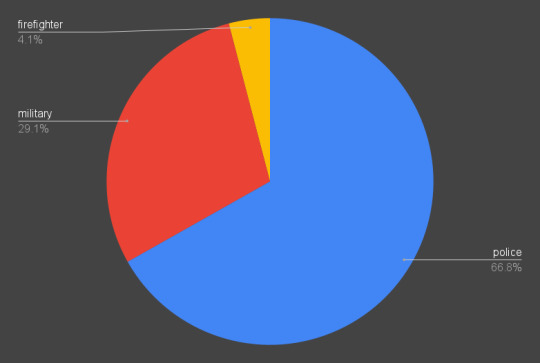
Every cited post has been assigned tags based on their contents, using an auto-tagging system I built a while back. It's helpful if you want to see other posts of the same country, agency, etc. - but it's also great at finding stats like...
Countries
This blog has been quite the world tour! I've mentioned a staggering 58 countries in my posts. But by country, who have I posted about the most?
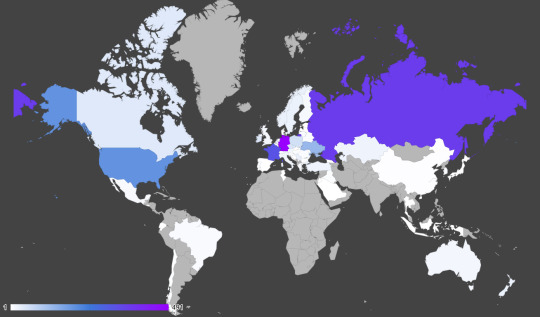
The top 5: Germany (491), Russia (369), France (321), USA (197), and Ukraine (131).
But enough about me - what did you all think of my posts? This next map is per capita, meaning the average number of notes each country's post got. (Countries with less than 5 posts are set to 0, and my reblogs are excluded.)
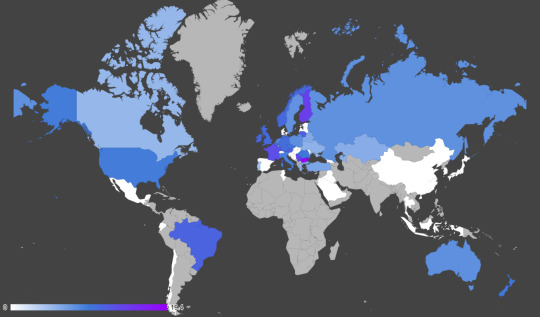
A surprising twist - Bulgaria takes top spot with 19.4 notes per capita! While their limited number of posts reveals a flaw in this measurement, the posts that are there really hit it off with the masked men lovers:


If you're curious, the runners up are Finland (14.3), Kosovo (14.1), Serbia (13.4), and France (13.0).
As an aside, I'd like to give a special shout out to the Czech Republic for stumping me the most when trying to cite posts from them. Where do you post your police photos?!?
Agencies
Okay, but which specific units have shown up the most this year?
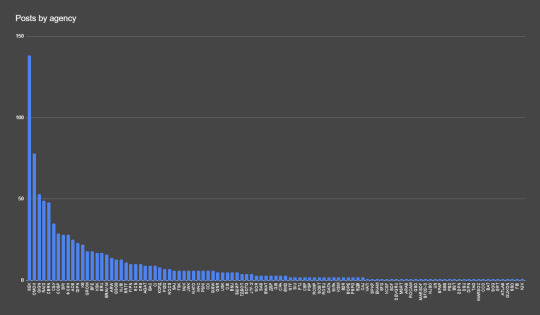
Just pretend CBRN and K9 are units :)
I guess it's not surprising, but I forgot how much I posted about Germany's SEK! Then, Russian (ОМОН) and French (GIGN, RAID) agencies aren't too far behind.
And what did you think?

French agencies drift to the top. I know some of you reading this really like GIGN, so it makes a ton of sense! PI2G simply ranks first because of their limited number of posts:


But GIGN (and GIPN, FIPN, RAID, CDI, whatever...) also did respectably in the rankings:


GSG-9 also beats the more regional SEK in terms of notes per capita. They might be cooler, but way too many posts claim photos of SEK officers to be GSG-9!!


Dates
Every cited post comes with a date. But when did things happen the most on my blog? (Approximate dates, e.g. "<2014", are excluded.)
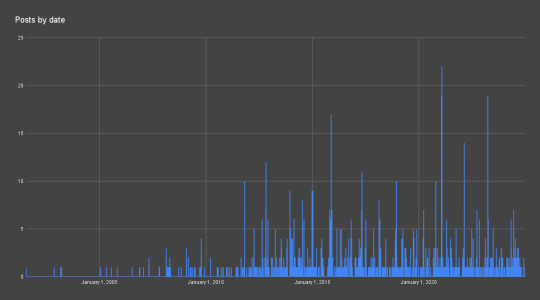
My earliest post is from July 20, 2001, during the G8 summit protests in Genoa:

And my latest post was December 26, 2024 - just a few days ago! A Swedish police officer searches for parachuters:

Some hotspots also arise in the graph. My most posted dates are:
January 31, 2021 (22 posts) and January 23, 2021 (19 posts) - Riot police during Alexei Navalny protests around Russia.
March 30, 2023 (19 posts) - German riot police exercise in Uelzen and Esterholz.
November 18, 2015 (17 posts) - French national police apartment raid in Saint Denis aimed at capturing Abdelhamid Abaaoud.
February 18, 2022 (14 posts) - Canadian riot police during COVID-19 protests in Ottawa.
Closing thoughts
To end off, I just wanted to say thank you to everyone who's followed this blog since I started it in May. I never thought I would sink this much time into collecting and sourcing images, building citation tools from scratch, finding VPNs, uncovering lost media... but here we are.
I read every note, so your comments, reposts, and deranged tags make the process all worth it :)
Whoever you are, wherever you come from, and whatever reason you follow my blog, thank you for sticking around. I hope you had a great 2024, and here's to a properly cited 2025!
-null

21 notes
·
View notes
Note
Hiii, so, I'm a random italian jane-austen-obsessed 15 years old girl and I just wanted to let you know that ur blog is amazing and it's my favourite on this app, and you're like a celebrity to me 😭 I love your content and I get so happy when you answers one of my asks or interact with one of my posts!! I swear you are like Taylor Swift level famous for me. If i think about Jane Austen, I think of you and your blog! You are also one of the reasons I'm now so passionate about her books!!! I wanted to thank you and let you know I so so admire you and you're so so so cool. <333
Thank you so much!!! I am so honoured and it's awesome that you love Jane Austen! I started reading her works when I was in high school too, after watching P&P 2005.
I am always hesitant to post asks like this because I don't want to seem arrogant, but I want to say: make sure you engaged with various different opinions on Jane Austen if you want to keep your mind open and challenged. I like to think that I stick very close to the novels and I try to use citations to support my opinions, but I'm one person with my own biases. I do reblog a lot of other people, but they are people I agree with (unless I'm arguing back).
What I'm trying to say is, don't take my word as the truth. Read other opinions, make your own conclusions (backed by evidence), and come back and fight me if you want, I'll be civil. If you read something that sounds wrong, check the source material. If you encounter something you don't understand, ask! And keep in mind that nobody has all the answers, none of us are channelling the spirit of Jane Austen and try as we might, we cannot completely ignore our 21st century mindsets.
But mostly, enjoy yourself! A love of reading is always something to cherish.
45 notes
·
View notes
Text
Scientific Literacy and Stray Cat Policies
Or how to read scientific papers and interrogate claims for accuracy.
I said in my previous post I eventually wanted to write something about how to read scientific papers and how to be aware of the ways a lot of credible sites summarize papers in a way that is misleading or inaccurate. Well since the topic came up yesterday now I've finally motivated myself to make this post so this is it. Although this is a bug blog, I will be focusing on specific claims made about cats because the way that scientific papers are used to affect policy is more direct and focusing on cats makes this topic more approachable and widely relatable.
I will be formatting this through the lens of finding a claim made on a site that has a citation, and how to read the original paper and compare it to the claim that the site is making. This I think is most applicable in everyday life. I'm also not a researcher or in academia, but I want to present this information as how to read a paper as a layman on a topic you don't have experience in. Hopefully by the end of this you'll have a greater sensitivity to statements made by secondary or tertiary articles, and you'll be more inclined to investigate information to it's source.
The other reason why I'm focusing this post on cats is because I ended up taking a deep dive into the policies we have about cats and how those policies are scientifically backed. We found a cat we had reason to believe was a lost pet a few months back, and we took him to a shelter so they could hold him while the owner was tracked down. During this, we were told the shelter doesn't take healthy cats, and that the policy was to put any cat you find back where you find it and "keep an eye on it", and the shelter would only take it if it was actively sick, injured, or starving.
This policy was based on guidance from the National Animal Care and Control Association.
We'll get to this is a second. Another shelter nearby that we tried had a similar policy, and their website included this graphic to explain that "When a cat is found outside, healthy and free from immediate danger, it is far more likely to return to its owner on its own."

This graphic has a source here, and we can see that it's one of the same sources used in the NACA findings.
The NACA findings consist of these main points:
Impoundment of healthy adult cats reduces the likelihood of reuniting families with pets
Impoundment of healthy adult cats may disproportionately impact under-served and marginalized communities
Impoundment has the potential to increase cat populations and impact
Impoundment fails to resolve the inciting factors for nuisance situations
Impoundment of healthy free roaming cats reduces capacity to respond to critical community needs
From the site, we have these references listed:

I'm going to focus on the first two points for space. The first two points seem to be the bulk of the argument for releasing found pets back outside and TNR is a whole other thing I don't really want to get into currently. Let's look at the first two references, which are describing lost pet cats and their owner's search and return methods.
This is the first reference, "Search and Identification Methods that Owners use to find a lost cat".
Scientific papers typically start with an abstract. The abstract is not the only thing you should read when looking at a scientific paper. The abstract is a summary that I like to think of more of a keyword organizer, it will briefly describe what the paper is about, what the author did, and what the author thinks the results of the experiment show. This paper shows the parts of the abstract very well, because instead of just a paragraph to sum up the whole thing it's broken down into sections.
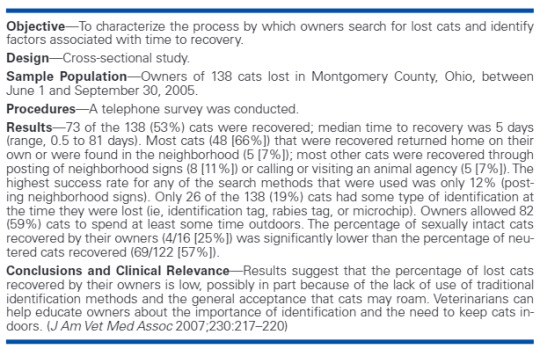
So we can see the purpose of this study was to look into how owners were looking for their lost cats, and what aids in cats being found. The study was conducted through a telephone survey, and the results show a breakdown of recovery methods that led to a cat being found. One of the things that immediately sticks out to me in this section is the first line that states "73 of the 138 (53%) cats were recovered". So right away we can see that the NACA site that claims that "In fact, the most successful reunification method for cats is the cat returning home on its own." is a misleading statement, while the majority of cats that were found returned home on their own, most of the lost cats were never found at all. Saying 66% of the cats that were found came home on their own is ignoring the fact that it's 66% of the total number of found cats, but only 34% of the total number of lost cats. Another thing that sticks out to me is the statement that "Only 26 of the 138 (19%) cats had some type of identification at the time they were lost." and that "Owners allowed 82 (59%) cats to spend at least some time outdoors". So the survey was done on a group of cats where a bit more than half were allowed to roam outside and a vast majority had no identification on them. Immediately I would assume that has an effect on how they were recovered, stray cats and indoor/outdoor cats are pretty common and people don't tend to immediately assume a cat they found outside is lost. And without an identification tag, anyone who did find the cat would not be able to return it to it's owner. The conclusions the author draws is also not that shelters should deny the intake of stray cats, but that we should "educate owners about the importance of identification and the need to keep cats indoors".
Let's look at the rest of the article though.
The next section is the Materials and Methods section. Depending on the paper you don't always need to read this, it will describe how the author collected the data, usually includes some information about the statistical relevance, or describe how the experiment was performed. Sometimes this section can highlight implicit biases in the way the data was collected, for example in this paper it states that "The study population consisted of a cohort of cats that had been identified as missing by their owners through placement of an advertisement in the lost-and-found portion of the classified section in the Dayton Daily News or through contact with 1 of the county’s 3 animal agencies". So they only surveyed people that posted a lost cat ad in the paper or directly contacted the shelter about their lost cat. This would exclude anyone that looked for their cat or put up lost cat posters but didn't happen to contact the shelter or run an ad, and the people who didn't look for their cat at all but just assumed the cat ran away. Biases like this are important to be aware of when interpreting the results of a paper, even if they don't have an apparent effect on the results.
Then we come to the Results section, which essentially gives the data as it was collected with no interpretations or conclusions applied. This section has a bit more about the specifics of the methods used, how long it took cats to be recovered, and whether or not having an identification tag made a statistic difference.
Last is the Discussion section, which is where the author interprets the results and draws a conclusion based on that. This is an important section to read because it usually gives some insight into what the authors think the data means. Obviously even researchers aren't infallible, but the authors have a lot more context and knowledge on the subject the paper is about and this can be helpful if you're reading a paper on a topic you're unfamiliar with. In this instance there isn't a lot of technical knowledge that's needed to understand the paper which is part of the reason why I chose to write about cat shelter policies.
In the discussion section, the author writes "These results may, in part, be due to the fact that no animal control laws related to cats existed at the county level in Ohio at the time of the study and that no identification was required for cats. There is tremendous debate as to whether cat licensing or mandatory identification is effective in reducing the cat overpopulation problem and whether owners of cats would comply with such laws." It is important to note that the paper still noted that there was only a small difference in returning cats with identification and that even in states where identification and microchipping is mandatory, although the return rates from the shelter for cats in states that require identification was higher than in Ohio where it's not required, the number was still much lower than it is for dogs. The author also notes that people generally take longer to contact their animal shelters about lost cats, and there was no mandatory holding period for stray cats at the time of the study but most agencies held stray cats for 3 days, which might have caused some of the lost cats to be euthanized before the owner contacted the shelter. Ultimately the author concludes that "we believe the present study illustrates the importance of educating owners about providing identification for their cats. We also believe the present study points to the need to continue to encourage owners to keep their cats indoors....Veterinarians can play a key role in educating owners on the health and safety reasons for keeping cats indoors and the importance of identification. Given that 56 of the 138 (41%) cats in the present study reportedly were not allowed outdoors, it is important to educate owners of indoor-only cats on the importance of identification and the potential risk that these cats will escape and become lost." The author does not seem to be concluding that because most of the cats that were found returned on their own, it is therefore better to leave stray cats outside. Instead the conclusion seems to be that people should be better about having identification tags on their cats, that they should contact the shelter early when they suspect their cat is lost and be proactive about following up with their shelter, and that cats should be kept indoors.
Let's look at the second study, the "Frequency of Lost Dogs and Cats in the United States and the Methods Used to Locate Them". One of the authors in this paper is the same author from the previous paper, Linda Lord. This doesn't necessarily mean anything but it's important to keep in mind if a website is citing multiple articles but the articles all come from the same author or data. I've even seen a website cite multiple sources, but when looking at these sources, all the sources were based on the same paper, which is also important to consider. If for example a website cites another website that talks about a paper and cites the paper itself as a different source, then it looks like there are two different sources for the information when really there's just one.
This paper's abstract is a lot more concise, with regards to cats it says "75% (95% CI: 64–85%) of cats were recovered...For cats, returning on their own was most common...Cats were less likely than dogs to have any type of identification. Knowledge of the successful methods of finding dogs and cats can provide invaluable help for owners of lost pets. Since 25% of lost cats were not found, other methods of reuniting cats and their owners are needed. Collars and ID tags or humane trapping could be valuable approaches." Right away we notice that the recovery percentage of cats is a lot higher than in the previous study, but that 25% is still a large percentage of cats that were never recovered. This is particularly interesting because this is the paper that the shelter cited on their website as the source for the information on their graphic about cat recovery, but again we can see the exclusion of the number of cats that weren't found is misleading.
From the Methods section, we can also see that the respondents to the survey in this paper were randomly called, and that they were asked about pets that had become lost within the last 5 years. This removes the bias of the previous paper of selecting only for people that used a local ad or went to the shelter to search for a lost pet.
The results are presented here largely as just the raw data in an Excel sheet, so I'm going to skip over to the Discussion section. In the discussion section, they say that "The definition of lost pets used in this study deliberately was designed to be broad so that owners of pets would include any time they were concerned about the absence of the pet from the home". The authors recognize that this could cause a discrepancy where there was no set time frame for how long a pet was lost for before the owner considered them lost, and they realized that people would respond to the survey under circumstances where other people might not consider the pet lost, and that allowing the pet to roam or be indoor-outdoor would change when or if the owner considered the pet lost.
The author also notes that "We did find that lost neutered pets, lost pets belonging to respondents with more education, and lost cats belonging to respondents with higher income were more likely to be reunited with their owners. This could be due to different behaviors of neutered pets or to different behaviors by owners of neutered pets. Since households with higher owner education and income levels were more likely to have neutered pets, these results could be due to some complex inter-relationships, which we were not able to study further due to our limited samples size. This does suggest future avenues for investigation evaluating other pet-keeping and health variables and their associations with human lifestyle and demographic variables." This paragraph appears to be the source of the claim from the NACA that sheltering healthy cats disproportionately affects marginalized communities. The statement the NACA makes about "Only ~40 % of people in the lowest income bracket (<$30,000 annual income) that lost cats were reunited with them, compared to > $90% reunited for those making $50,000 or more per year" seems to be based on this paper, but the actual data to back this up is presented as such:
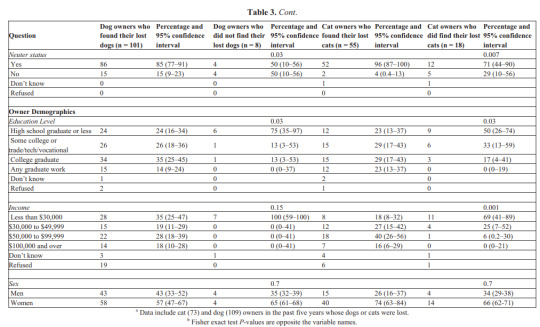
So for people making less than 30k$ per year, 8 of the cats were found vs the 11 who weren't found, which does make about 40% found. The 90% seems to be based on adding up all the found vs unfound cats for people in the above 50k$ range, so 25 total found cats vs 1 cat that was not found. This makes 96%, which is >90% but I guess it's a bit too high of a percentage to seem accurate. It's also possible they added in the Don't Know category, I'm not sure exactly what they looked at to get the 90% number. The point is that the statement about taking cats into shelters affecting marginalized communities is a statement based on a total of 50 cats (excluding the 30-49k bracket) which the authors of the paper say is not enough data to make a definitive statement about.
The NACA website also points to the low usage of shelters through a program designed to reach low income communities, and the authors of the paper state that "Since the majority of cat owners that lose and do not recover their cat did not search at the animal shelter, there is likely an opportunity to increase messaging regarding this option as a search method for cat owners...These results may suggest that a proportion of “stray” pets in shelters are actually lost as opposed to abandoned by their owners. Lost pets in shelters may not be reunited with their owners if the owners do not know that there is a shelter that might have their pets." It seems that low usage of shelters and the extended time cat owners take to reach out to their local shelters does contribute to the low number of cats that are recovered from shelters, but to say that because of this cats shouldn't be kept at a shelter at all seems to be backwards. More education about shelter services and encouraging pet owners to utilize their shelter more and reach out earlier when their pet is lost would likely improve pet recovery from shelters. If shelters made it a policy to not hold pet cats then obviously people would not reach out to shelters to recover a cat since it is likely that the cat in question would not be at the shelter.
The author concludes "Animal shelter staff and veterinarians can provide a valuable service by making available information on how owners of lost pets can best find their pets. They could also help owners find their pets by instituting matching of reported lost pet records with reported found pet records. Veterinarians might offer microchip and identification tag clinics for community pet owners and be sure their own clientele’s pets have microchips, collars and personalized identification. Veterinary clinics and animal shelters could have a list of resources and options for advertising for lost pets; some local papers will publish a lost pet ad free and many shelters have lost and found sections. Local veterinary associations could support advertisements for lost pets...Since 25% of lost cats were not found, other methods of reuniting cats and their owners are needed. It is possible that collars and ID tags or humane trapping could be valuable and more work is needed to determine this. Veterinarians and animal welfare professional can play a key role in helping pet owners if their dogs or cats become lost by guiding owners to use active methods to find lost pets, particularly within the owners’ neighborhoods." Again, we see a distinct lack of suggestion that the conclusion of the paper is since most cats that are found returned home on their own, the best policy for shelters to have is to not accept any stray cats. The suggestion from the author is about further education on the importance of identification, guiding pet owners to more effective methods of searching for their pets, and maintaining lost and found pet records.
Both of these articles are presumably used to support the claim from the NACA site that states "Lost cats are 10-50 times more likely to be reunited with their owners if they stay in the neighborhood of origin than through an animal shelter. In fact, the most successful reunification method for cats is the cat returning home on its own". Based on reading through these two articles, they seem to be combining first article which states that 48 (66%) of the cats came home on their own vs the 5 (7%) which were found at the shelter and the second article which says 32 (59%) of the cats came home on their own vs the 1 (2%) cat that was found at the shelter. Again we can see that this claim is misleading based on the data it's sourced from, the sample size is very small and there were other factors stated in both cases that contribute to the low use of animal shelters in returning cats.
Based on these two articles, the NACA has concluded that shelters should not take in healthy stray cats. This includes cats that have evidence of being owned and lost, or evidence of being abandoned and adoptable. The cat we found had a microchip, but the phone number listed on the microchip was disconnected and the address listed had been recently moved into and the current tenant was receiving old mail from the owner listed on the microchip. Because of this, we had solid reason to believe this was a pet cat that had been lost or abandoned, and yet still the shelter was using a misleading policy written on the basis of obfuscating the actual suggestions the author made in the article it cites.
By finding the original source of these claims, and reading what the source article says, how the data was collected for the source article, and how the author of the source article interpreted this data, we can improve the way we engage with claims and facts presented on various websites and media outlets. This is going to be a two part series (at least) with the second part discussing claims on outdoor cat health, but I hope this was enough to encourage you to read the scientific articles that are at the source of a lot of policy decision and public perceptions.
Part 2
#scientific research#scientific literacy#misinformation#cats#lost cats#stray cats#shelter cats#animal shelters#long post
20 notes
·
View notes
Text
About Me
This is a side blog so I don't annoy my irl friends with Christian discourse lol. I'm Bel. My identity is foremost Christian and then, in no particular order: Lutheran, queer, trans, white, USAmerican. Also some other things but these are the perspectives I cannot speak outside of.
I am a first year seminarian and candidate for ministry! My current ministry interests are expressions of future church life, pathways to Christianity for the (interested) un- and de-churched, reclaiming Christianity from the American right-wing, and intra- and interfaith ecumenism. (Phrasing borrowed from Amos Yong.)
My ongoing theological/historical interests are forgiveness, the Judaic roots of Christianity, universal salvation, universalism/religious plurality, queer theology, the Apostolic Age, Patristic Age and Reformation. This doesn't mean these are areas of expertise but rather areas of exploration and questioning.
I like to argue, a word which here means to make reasoned statements to prove or refute an argument, especially for the purpose of learning. I do not like to fight. I value source citation, precision in language, and sincerity. I want to really stress again that arguing is fun for me, so if I'm arguing on your post and it's not fun for you, just block me. Or if you want to continue the discussion but it's not fun, let me know and I'll adjust my tone.
Thanks for reading, peace be with you.
PS the cat in my header is Patches and that's her laying on one of my Bibles while I read a different one because I couldn't make her leave <3
12 notes
·
View notes
Text
pinned post
about:
hi im Radley. im 24. he/him. main blog @jacebeleren.
i saw the rats music video in 2018. since that encounter, my life has never known peace.
obsessed with the band ghost lore. i think other fans should have access to knowledge / lore and i hate misinformation and i always include citations with links to the original sources and i just think that's so sexy of me <3
i created an archive of ghost concert videos. 661 videos for era 1 and 2637 videos for era 2 are now available.
favorite song: witch image
favorite album: meliora (obviously)
rituals attended: Los Angeles 3/3/2022, Atlanta 9/3/2022, Los Angeles 9/12/2023, San Diego 8/10/2025 (upcoming!!)
tag list:
papa emeritus i (specifically as papa) / primo (any depiction / mention)
papa emeritus ii (specifically as papa) / secondo (any depiction / mention)
papa emeritus iii (specifically as papa) / terzo (any depiction / mention)
cardinal copia (specifically as cardinal copia) / papa emeritus iv (specifically as papa) / frater imperator (specifically as frater imperator) / cardi (any depiction / mention)
papa v perpetua (specifically as papa) / v (any depiction / mention)
papa nihil (specifically as papa) / nihil (any depiction / mention)
sister imperator
fan art
headcanon (any headcanons posts, mine or others)
the band ghost lore (canon / official lore stuff)
quotes (posts including quotes from official media)
radley post (my own posts)
will update tag list as needed 👍
30 notes
·
View notes
Text
hey! making a pinned that will for now hold some basic info/disclaimers & may in the future have a read more with a guide to deep dives
navigation
james/lorraine, they/he/she, 24. BA in religious studies/history, going back for a MA in history in january (that's relevant okay that's my CREDENTIALS for this silly blog)
my main is @menlove
I am indeed a shipper! no hate is meant at all by this blog existing, I'm just a historian that is going crazy trying to sort out fact & fiction in this fandom. there's a lot of both and I think a blog like this could be useful
and in that vein, I will never, ever directly come after or @ anyone who shared that misinformation. if you send me a request and start it with "I saw so and so post x, is this real?" I'll make a post without your ask in it. I don't want to send hate anyone's way. if it's an older post, i'll probably link the source of the misinformation for the sake of clarity, but if it's a blog that's still active i won't & i'll just screenshot. (maccaswife1978 is not a real person btw dgshdhshs. as far as I know! sorry if anyone's ever had that username)
I'm always open to correction. I have 0 way of knowing or finding everything, so if you have a credible, reliable source that I didn't find in my deep dive of something I rated fake/neutral, please let me know! I'd love for some of these to be real
I also take requests! feel free to ask me about anything that you want fact checked. just know sometimes I might not be able to find an answer or I might be bogged down & not be able to answer just then. I'll do my best to get to everyone, but inevitably my mental health and life Will come first so......
rating system
fake- this is a source that, from everything I can find, only loops back to other mclennon blogs/forums. again, I'll take correction on these.
neutral- this is a source that is fake in some way but real in others. maybe it's a quote taken wildly out of context, or the quote passed around is fake but the content really did happen & has a more grounded source. or maybe it was written in a biography that didn't use citations and I have no idea where that author got that information, so you should take it with a grain of salt. or maybe it's something that isn't necessarily fake, but there's not enough evidence to definitively prove it one way or another (i.e. did anything happen in india?) whatever the case, this source has ended up neutral in the grand scheme of mclennon.
real- happy day for us all, these are for ones that turn out to be real! these are ones that are backed up by one or more reliable source & have hard evidence
source reliability
what do I mean by "reliable source"?
for me to count a source as "reliable" and count it towards a fact/quote being real, it has to be one of these things: first-hand (interviews, auto biographies, etc), recorded (video/photographic evidence, basically), or a well-sourced/respected biographer.
sources that fall into the in between category and might still earn a "real" rating but should be taken with a grain of salt are things like: second-hand sources (& who they are is important in determining how big that grain of salt should be), biographers who are allergic to sourcing, and things like lyrics/poetry/short stories which rely heavily on interpretation unless explained by either john or paul themselves. none of these automatically mean a "neutral" or "fake" rating, but they're taken into account.
and sources that will earn a fake rating once they're found to be the original source: tumblr blogs, deviantART pages, fan forums, gossip columns, etc. basically, if all I can find is someone writing out "slash beatles quotes" on a page in 2011, it's getting chucked in the bullshit pile unless someone else can find a source that predates it.
34 notes
·
View notes
Text
Welcome to Sheydmade
© 2024 Keziah Zibelmann. All content on this blog is the property of Keziah Zibelmann. Please refer to individual articles, posts, and sections for citation and source information. Refer to the Info & Rules section below for permissions.
Sheydmade is a collection of articles, essays, blogs, and resources on witchcraft, divination, folklore, mythology, demonology, magic, and history related to such topics (all written by Keziah). Sheydmade aims to serve as a resource to the world of witchcraft practitioners and diviners, no matter their creed, ilk, or experience level.
(Our current top posts are - 1. Jewish Incantation Bowls; 2. the Craft of Isobel Gowdie: A Look at Scottish Folk Magic in the 1600s; 3. Simple Methods of Magical Protection; 4. Protection Work in Folk Magic: Herbs, Charms, & Spells for Protecting Yourself & Others; 5. the Otherworld of Irish & Welsh Mythology)
About Keziah: Keziah is a witch, diviner, writer, and scholar from the Southeastern US. Keziah has been practicing divination and witchcraft for over 20 years and has served as a professional diviner (tarot readings, palm readings, dream interpretation, spirit communication, etc.) for over a decade.
Quick bits and bobs: Aquarius/Gemini/Aquarius | Mixed (Black and white) | Jewish (Ashkenazi - Alsatian and Galician; not really secular but more spiritual than religious? I don't know. I'm on a journey.) | Queer (nonbinary - she/they; pansexual) | Early 30s and loving it | Polyglot | Religious studies nerd | Meditator | Ruminator | Queen of vegan jambalaya and babka. (Find more at our about page.)
Links: Instagram | Threads | Bluesky Thorn & Thread (blog ring; site currently under construction) HillbillyBubbeleh (personal sideblog)
Info & Rules:
Sheydmade is best viewed on a computer. If you're viewing on mobile, you may not have access to the full library of articles, posts, and resources.
Plagiarism and theft will not be tolerated. All content posted on sheydmade is original, written by Keziah, and any sources used in creating that content are listed at the bottom of every post. If plagiarism, theft, cross-posting without permission, etc. is discovered, you will be reported, blocked, and potentially sued should the situation call for it.
While parts of the witchcraft community have been known to have their fair share of appropriation, problematic behavior, toxicity, bigotry, and more, there will be no tolerance for such things on sheydmade. Any comment or reblog featuring hate, bigotry, or problematic/abusive behavior will be removed and/or, if necessary, your account will be reported and blocked.
Sheydmade is for everyone except bigots. If you follow this blog and there is content in your bio or on your page that is anti-LGBTQIA+, racist, sexist, xenophobic, antisemitic, Islamophobic, fascistic, abusive, predatory, in any way harmful to marginalized communities, or in any way promoting supremacist, neo-N*zi, TERF or other harmful rhetoric and ideologies, your account will be blocked. We do not share resources with bigots.
These writings are meant to be an exploration and appreciation of witchcraft in its many forms. While some of the holidays and customs that are written about are not part of the author’s personal practice, the author writes from a historical perspective and always thoroughly researches each post and includes citations and sources. The only closed practices that may be written about are within the author's own cultural customs and magical and/or religious practice. With respect, we ask that boundaries are maintained and closed practices are not encroached upon.
Thank you for visiting sheydmade! Enjoy!
7 notes
·
View notes
Note
In regards to the debunk you put. Pro endo ≠ Pro fakers
Hope this helps :)
Are you the person who made those posts?
Sending this on anon after your hostie got tired of you publicly humiliating yourself, made you delete your blog and put you in a time out?
Anyway, reminder that willogenic and protogenic systems are not faking and are largely the ones who created the endogenic community. You would know this if you had even the slightest understanding of plural history.
But you don't seem to have the slightest understanding of anything at all.

Is the reason you consider "thinking" a "strange phenomenon" because you are so fundamentally incapable of doing it?
Psychologists have studied tulpamancy. They've affirmed it as a real psychological phenomenon.
They've published peer reviewed studies on it through reputable publishers like Oxford University Press.
Frankly, even the suggestion that tulpamancers have written hundreds of guides for a practice that doesn't work, some of which are novel-length, and distributed them for free with nothing in return is pretty absurd. As is the suggestion that tulpamancers somehow can't distinguish between an inner monologue and a dialogue.

"Scientifically proven" how???
Where is the study? What was its methodology? Who conducted it? What was its scope and limitations? Did the study actually look at nonpathological forms of plurality or ONLY at DID? Heck, did it even look at other forms of CDDs?
If you've ACTUALLY done the research, you should have zero problem answering these questions. But something tells me you've never read a single peer reviewed paper in your entire life.
See, I've actually read academic papers. I've compiled my own list of resources for easy citation.
But you strike me as someone who is pretending. You're pretending to be educated and pretending to have done your own research when you've probably just formulated your opinions from random posts on the internet and TikToks.
In all this time, I've never once see a single instance of a psychiatrist or psychologist even claiming that you need negative experiences to be plural. I don't think the sources you're talking about actually exist.
This whole "scientifically proven" claim is just an argument by assertion. You're hoping that if you repeat it loudly and often enough, eventually people will believe it.

I mean, it was a "single" spelling error you made twice. If you make it once, it's a typo. When you make it twice, it's you honestly thinking factitious disorder is "factive disorder."
And I think that does demonstrate how little research you've actually done into psychology and how YOU DON'T UNDERSTAND ANYTHING YOU'RE TALKING ABOUT.

Yeah, I'm calling you an anti-endo and a sysmed because you are through your actions, regardless of whatever label you might identify with.
I think even the coiner of 'endogenic systems' would agree with my assessment seeing as they already told you off.
In the end, this is all you have.
Arguments by assertion and personal attacks. You cling to these because you have nothing else to offer an intellectual discussion. And in the end, you just have to resort to endless childish namecalling.
#syscourse#systempunk#syspunk#pro endogenic#pro endo#sysblr#multiplicity#actually plural#actually a system
16 notes
·
View notes
Text
Tumblr should really let you pin multiple things as a blog introduction. (I wish).
Anyway, hi, hello, (new friend?), I'm Brb/Birb/(real name redacted). I'm an almost graduated student from the general land of cornfields and more cornfields. There's not much around, that's why I'm here, lol. (Also I've met a bunch of cool people, so now I think I'm kind of stuck here - come join us!).
⚔️🐦⚔️🐦⚔️🐦⚔️🐦⚔️🐦⚔️🐦⚔️🐦⚔️🐦⚔️🐦⚔️🐦⚔️🐦
If you happen to be a New Person Who Has Found Me (Hello!) and You Want To Talk to Me, I don't bite, I swear. I am a Birb with the heart of a Golden Labrador Retriever. Feel free to Tag Me in any tag games or haunt my inbox. <3 Come say hi! i love friends.

((Art by the amazing @mayamohini jfkfjjfkjgjgjgjfj it’s gorgeous)
(my "character sheet" that is based on my real life attributes--yes, I did roll all of these numbers. I use canva a totally healthy amount sometimes)

⚔️🐦⚔️🐦⚔️🐦⚔️🐦⚔️🐦⚔️🐦⚔️🐦⚔️🐦⚔️🐦⚔️🐦⚔️🐦
Anyway, more information y'all should know: This is the main account; I do have a sideblog. I reblog a lot of friend's nonsense, post a lot of my own even more nonsense, kind of have a whole "I want to be a hobbit living my best life somewhere not here vibe" I think. You will also see posts about things I think are wholesome/sweet, writing, psychology, fantasy, whatever fandom I'm in (or a friend's fandom),....just general nonsense I suppose. I do post some amount of life stuff when relevant or whenever I find things funny. Although the pic above is an owl, I am probably more akin to a magpie with much reblogging of things I find "shiny" to add to the chaotic mess that is my tumblr dashboard.
⚔️🐦⚔️🐦⚔️🐦⚔️🐦⚔️🐦⚔️🐦⚔️🐦⚔️🐦⚔️🐦⚔️🐦⚔️🐦
@brb-on-a-side-blog is also me! This was created to hopefully separate original writing content from the rest of the reblogging I do so it doesn't get buried in theory. This may not work out in theory as well as in practice, but I promise to reblog the cool writing stuff to my main blog if you don't want to have it clogging up your dash :).
There are other ones but as I am currently not using them it seems futile to put in an intro post.
⚔️🐦⚔️🐦⚔️🐦⚔️🐦⚔️🐦⚔️🐦⚔️🐦⚔️🐦⚔️🐦⚔️🐦⚔️🐦
Tags to help sift through to find me in the hoard of posts!
#brb-rambles: Original thoughts about something (or at least as original as I can be).
#brb-(insert part of moots name here): interactions between me and said moot! I'm actually really not great at this but will get better and I forsee mass post editor being a BFF if I do this.
#brb-life: original content relating to my life/thoughts.
#brb-writes: original writing content (this will be potentially moved to sideblog).
#brb-memes (i make memes sometimes).
#brb-library: posts that are either really funny/really struck me so I'm going to save them to print out
#brb-adventures: the hopeful travel tag for some upcoming trips (either the grocery store or New York who knows).
#brb-learning-things: Things I have learned (although it's from my school/classes so questionably but I reason sourced; if it's not, I'll include source link/some kind of citation).
#brb needs a laugh check: I am joking. Please do not take me seriously.
#brb vs the call of the academia: school posting?
#brb-asks/#brb-report:s hopefully new ask tag if I can remember to add them.
#dear north canada love south canada (and associated tags I will not be typing out here) is a fun series I have with @igotthisaccountunderduress (she's absolutely cool, check her out). Again, that won't cover all the posts but again, vibes).
#Also I have AO3 under same blog name: brb_on_a_quest#It's mainly to start organizing my stuff ((cuz i don't want to organize in real life but need feel some sense of control lol).#fair warning; my intro posts/pfp may change a fair amount bc i have tendency to change aspects of my presence like clothes#not the url bc i know that causes too much chaos#brb-rambles#brb-life
28 notes
·
View notes
Note
Hi, I'll preface this by saying that I'm a fan of your writing and this is not a rant at you specifically. It's something that I'm growing more and more frustrated with when navigating content/creations in the fandom (and other fandoms on here too tbh). Your posts just happened to be the ones I came across today and they provide a convenient case study into the matter.
I politely appeal for you to insert gif credit and sources in posts like these: https://www.tumblr.com/lookingfts/752534640842211328?source=share and https://www.tumblr.com/lookingfts/752585046132752384/this-ridiculous-little-man-with-his-stupid-little?source=share
From what I can tell (unsure about the s3e1 bedroom one) but the other two come from: https://www.tumblr.com/chenfordsbee/752307297817165824/kanthony-hands?source=share and https://www.tumblr.com/bakerolivia/750875519674892289/anthony-bridgerton-and-benedict?source=share
I think we all know that the inbuilt tumblr feature to embed existing gifs in posts is very broken (where it automatically credits, and links you back to the full set when you click the text/username under it), and it can be very frustrating to find the exact one you want.
But reposting them yourselves without credit is seen as very bad etiquette amongst creators, and a lot of creators will block people for this reason (to avoid said person collecting and reposting their future content), and warn their fellow creator mutuals to do so too.
Also, it makes the user experience quite annoying for some users. i.e. You see a post with a really cool gif; you swore you've seen that exact one before, you may even recognise the very specific style/coloring, OR you've not seen that scene giffed before but you've wanted to, you now really want to like/reblog the full set if you could find it. Either way; you wish you could see the whole thing from the original post. But there's no link or even an indication as to the original creator/blog it came from, so... yeah this sucks.
From your other posts you seem like a reasonable and well intentioned person, so I don't think you're setting out to be deceptive in any way (some will actually fully repost a mish mash of different sets, and caption and tag it as if it's their own creation), you just want to scream about your faves, as you should. And I'm sorry this got so so long but I think I need to make it really clear, because I assume that some of these reasons/povs/repercussions must be unknown for it to keep happening. I could go into how it affects creators in fandoms in more detail but I'm sure you can imagine and I don't want to extend the lecture (just imagine someone copying and pasting excerpts from your fan fiction, and posting it, without any citation of said fan fiction or even mention of the author).
TLDR - Please link back to the original post if you're sharing stand alone gifs, made by someone else, in your own posts. Or better yet, reblog the original post that you're downloading the images from, with your added commentary (we would actually LOVE to see it, but I do also get if you just want to pluck out one specific moment from the set).
An example:
[THAT ONE GIF FROM THAT MOMENT YOU REALLY WANT TO POST ABOUT]
GIF by @tumblrusername
Blue font to illustrate that this is a hyperlink to the original set. I just based this on the way the aforementioned broken inbuilt one is formatted, but as long as you @ the user (this pops a mention into our activity just like the inbuilt feature does so we can come scream along with you) and link the applicable post in some clear way it's all dandy and helps everyone out.
I really hope that this doesn't come across as hostile, and that you answer so it can be shared to make others more aware too.
Thank you for asking this. You're totally right - I have not been thinking about crediting gif creators, and that's something I need to learn!
I'm still very new to Tumblr and learning the ropes. I didn't really intend to post S3 gifs at all - I was keeping Kanthony photos/gifs I liked on my phone to share with friends, and eventually I realized how many I had saved, so I decided to start making posts with them, and I was simply uploading them from my phone at that point.
You see so many gifs floating around here - I didn't think closely about the time and effort that people are going through to create these gifs, and I will do better in giving them the recognition and attention they deserve. (If one of the gifs I've used is yours, please let me know and I will tag you.)
Thank you to everyone in the fandom for contributing their art, and thank you for standing up for creators.
23 notes
·
View notes
Text
Oh my god, I think I just skimmed two entire blog posts ostensibly about Controlled Digital Lending through the lens of Hachette, but which failed, at any point, to mention the actions of IA that lead to the filing of the complaint in Hachette. If you put together a beautiful argument in favor of CDL, it kind of destroys itself if you hinge a large chunk of it on the proposition that no, it really is one-to-one owned to loaned and it is *impossible* for it to be otherwise!*
*Trial advocacy tip 1: don't ignore your bad facts.
(It also claims that "IA is a library by every definition." Which. First: lol, piss off.** But second, its citation for this is 1) an argument by a small handful of university libraries that fails to provide evidence that it even meets the complete definition of a library that they themselves proffer*** and 2) an article from 2007 stating that California recognized it as a library...for the purposes of allowing it to apply for federal grant programs administered by CA...(apparently) under an exception for "other special library"****....an exception which it seems may no longer exist.)
**Trial advocacy tip 2: Don't comically overstate your argument.
***Most notably, one of the listed characteristics of a library is that it "offer[s] targeted services and programs." They do not offer any evidence that comes even close to meeting that prong of the definition.
****Caveat that this is an unverified comment from an old blog, but the information provided matches the controlling guidelines from 2007. (And also the only other source for the IA's "accreditation" is a post on the IA's blog and a 15+ year old post from a local paper that cites wikipedia. So I don't feel the need to track down more reliable sources unless the IA provides them first.)
30 notes
·
View notes
Text
A week after its algorithms advised people to eat rocks and put glue on pizza, Google admitted Thursday that it needed to make adjustments to its bold new generative AI search feature. The episode highlights the risks of Google’s aggressive drive to commercialize generative AI—and also the treacherous and fundamental limitations of that technology.
Google’s AI Overviews feature draws on Gemini, a large language model like the one behind OpenAI’s ChatGPT, to generate written answers to some search queries by summarizing information found online. The current AI boom is built around LLMs’ impressive fluency with text, but the software can also use that facility to put a convincing gloss on untruths or errors. Using the technology to summarize online information promises can make search results easier to digest, but it is hazardous when online sources are contractionary or when people may use the information to make important decisions.
“You can get a quick snappy prototype now fairly quickly with an LLM, but to actually make it so that it doesn't tell you to eat rocks takes a lot of work,” says Richard Socher, who made key contributions to AI for language as a researcher and, in late 2021, launched an AI-centric search engine called You.com.
Socher says wrangling LLMs takes considerable effort because the underlying technology has no real understanding of the world and because the web is riddled with untrustworthy information. “In some cases it is better to actually not just give you an answer, or to show you multiple different viewpoints,” he says.
Google’s head of search Liz Reid said in the company’s blog post late Thursday that it did extensive testing ahead of launching AI Overviews. But she added that errors like the rock eating and glue pizza examples—in which Google’s algorithms pulled information from a satirical article and jocular Reddit comment, respectively—had prompted additional changes. They include better detection of “nonsensical queries,” Google says, and making the system rely less heavily on user-generated content.
You.com routinely avoids the kinds of errors displayed by Google’s AI Overviews, Socher says, because his company developed about a dozen tricks to keep LLMs from misbehaving when used for search.
“We are more accurate because we put a lot of resources into being more accurate,” Socher says. Among other things, You.com uses a custom-built web index designed to help LLMs steer clear of incorrect information. It also selects from multiple different LLMs to answer specific queries, and it uses a citation mechanism that can explain when sources are contradictory. Still, getting AI search right is tricky. WIRED found on Friday that You.com failed to correctly answer a query that has been known to trip up other AI systems, stating that “based on the information available, there are no African nations whose names start with the letter ‘K.’” In previous tests, it had aced the query.
Google’s generative AI upgrade to its most widely used and lucrative product is part of a tech-industry-wide reboot inspired by OpenAI’s release of the chatbot ChatGPT in November 2022. A couple of months after ChatGPT debuted, Microsoft, a key partner of OpenAI, used its technology to upgrade its also-ran search engine Bing. The upgraded Bing was beset by AI-generated errors and odd behavior, but the company’s CEO, Satya Nadella, said that the move was designed to challenge Google, saying “I want people to know we made them dance.”
Some experts feel that Google rushed its AI upgrade. “I’m surprised they launched it as it is for as many queries—medical, financial queries—I thought they’d be more careful,” says Barry Schwartz, news editor at Search Engine Land, a publication that tracks the search industry. The company should have better anticipated that some people would intentionally try to trip up AI Overviews, he adds. “Google has to be smart about that,” Schwartz says, especially when they're showing the results as default on their most valuable product.
Lily Ray, a search engine optimization consultant, was for a year a beta tester of the prototype that preceded AI Overviews, which Google called Search Generative Experience. She says she was unsurprised to see the errors that appeared last week given how the previous version tended to go awry. “I think it’s virtually impossible for it to always get everything right,” Ray says. “That’s the nature of AI.”
Even if blatant errors like suggesting people eat rocks become less common, AI search can fail in other ways. Ray has documented more subtle problems with AI Overviews, including summaries that sometimes draw on poor sources such as sites that are from another region or even defunct websites—something she says could provide less useful information to users who are hunting for product recommendations, for instance. Those who work on optimizing content for Google’s Search algorithm are still trying to understand what’s going on. “Within our industry right now, the level of confusion is on the charts,” she says.
Even if industry experts and consumers get more familiar with how the new Google search behaves, don’t expect it to stop making mistakes. Daniel Griffin, a search consultant and researcher who is developing tools to make it easy to compare different AI-powered search services, says that Google faced similar problems when it launched Featured Snippets, which answered queries with text quoted from websites, in 2014.
Griffin says he expects Google to iron out some of the most glaring problems with AI Overviews, but that it’s important to remember no one has solved the problem of LLMs failing to grasp what is true, or their tendency to fabricate information. “It’s not just a problem with AI,” he says. “It’s the web, it’s the world. There’s not really a truth, necessarily.”
18 notes
·
View notes